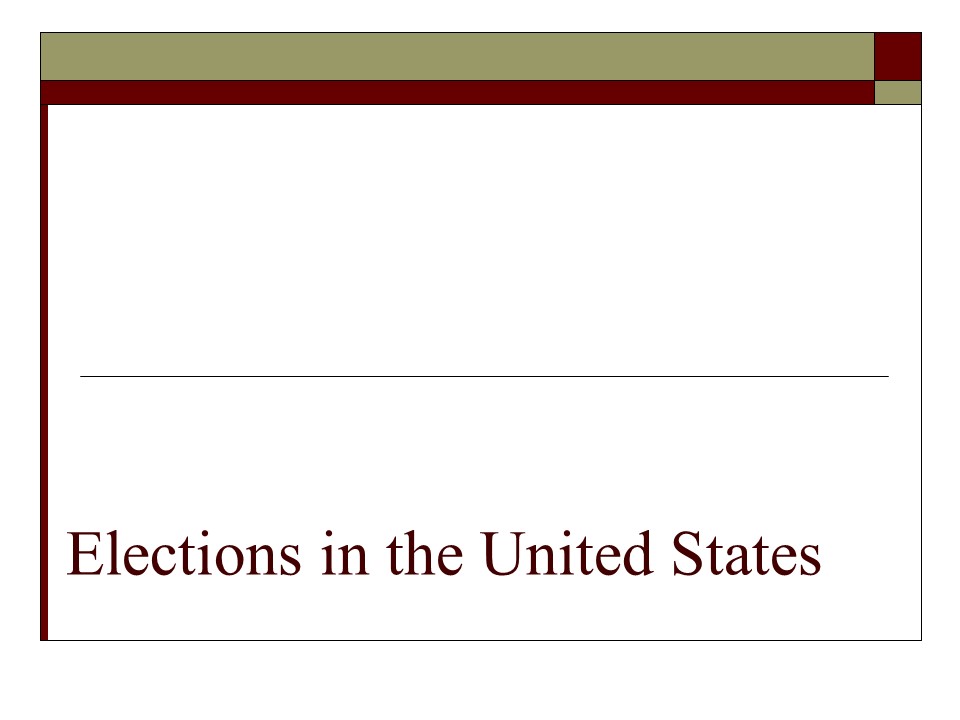Elections in the United States - PowerPoint PPT Presentation
Title:
Elections in the United States
Description:
Elections in the United States – PowerPoint PPT presentation
Number of Views:138
Avg rating:3.0/5.0
Title: Elections in the United States
1
Elections in the United States
2
Purpose of Elections
- Founders called it Popular Sovereignty
- Political Power is derived from the consent of
the governed - Elections fill public offices and staff the
government - Elections also hold the Government accountable to
the public
3
Types of Elections
- Presidential Elections (General)
- Primaries
- Congressional Elections
- Mid-term Elections
- Referendum on the President
- State and Local
- Initative, Referendum, and Recall
4
Presidential Elections
- Primary Elections
- Voters decide which of the Candidates within a
party will represent the partys ticket in the
General Elections
5
Types of Primaries
- Closed
- Only a registered party member is allowed to vote
(FL, LA, NY, CA) - Open
- Any member of the Electorate can vote in either
primary (GA, AL, TX, VA) - Crossover voting does occur frequently in Open
Primaries - There is little evidence to support raiding of
primaries - Runoff
- Second Primary election between the top 2 vote
getters - LA is a little strange
6
Primaries Scheduling
- Critics argue unfair scheduling of Primaries
affects their outcomes - Take New Hampshire. Who really cares what the
think? But because they are the first primary in
our nation some say they get way too much media
coverage and affect the opinions of the
electorate in more populous states that hold
their primaries later
7
Leads to Front Loading
- Front Loading- the tendency of states to chose an
early date on the primary calendar - Parties have finally said enough is enough and
have taken delegates out of states who continue
to move up their primaries - Ex. Michigan
- Super Tuesday- In 1988 14 southern states began
Super Tuesday to maximize the Souths influence
on Presidential Politics
8
Party Conventions
- All the States report the number of delegates
voting for a candidate - All the candidates give a brief speech supporting
the Nominee - The Partys nominee gives a speech about how
he/she will change the world - News Coverage is extensive which leads to the
Convention Bounce
9
Electing the President
- The President is not elected by a Direct Vote
- Congress is a direct election
- The Gubernatorial election is a direct election.
- The President is elected by the Electoral College
10
The Electoral College
- Like most things at Constitution the Electoral
College is a compromise - Direct Popular vote and Congress choosing the
President - Electors were meant to be men of character with a
solid knowledge of national politics
11
What is the Electoral College?
It is the constitutional system used to elect the
Chief Executive. Established by Article II of the
Constitution and the 12th Amendment (1804). Each
state is assigned a specific number of
electors. When you vote for President, you are
actually voting for the group of electors from
your state.
12
Once again....
When you cast your vote, you are actually voting
for the ELECTORS from your state. The candidate
that gets the most votes in your state, gets
those electors. WINNER TAKE ALL SYSTEM!!!!! If
you win a plurality of the votes, you get EVERY
VOTE!!!!
13
To Find the Number of Electoral Votes for a state
So There are 538 Electoral Votes on the map To
win 538/2269 A majority is 50 1 So to be
President you need 270 Electoral Votes
Number of Representatives in the House Number
of Senators (Always 2) Total Number of Electors
TO WIN THE WHITE HOUSE YOU MUST WIN A MAJORITY OF
ELECTORAL VOTES
The candidate that wins the popular vote in that
state gets all that states electoral votes
(except for Maine and Nebraska).
14
What if no candidate gets a majority of the
electoral vote?
Should none of the candidates win a majority of
the electoral votes, the 12th Amendment kicks in
and the election is decided by the House of
Representatives. The combined representatives of
each state get one vote and a simple majority of
states is required to win. This has only happened
twice. Presidents Thomas Jefferson in 1801 and
John Quincy Adams in 1825 were elected by the
House of Representatives.
15
Why do we have the Electoral College?
Concerns of Founders President would use
military to overpower states Would use office to
hold power through force and corruption Protectio
n against the ignorant masses Areas of small
population would be ignored Results Large states
have more say, but small states are guaranteed at
least 3 electoral votes
16
(No Transcript)
17
Mid Term Elections
- Off Year elections- In-between presidential
elections - Less Participation than a Presidential Election
- The presidents party normally loses seats during
this election - Midterm Elections serve as a REFERENDUM on the
President - 2006 Mid Term election Republicans lost 30 seats
in the house and 6 in the Senate giving the
Democrats control in Congress
18
Initiative, Referendum, Recall
- Initiative- An election that allows citizens to
propose legislation and submit it to the state
electorate for popular vote - Referendum- An election whereby the state
legislature submits proposed legislation - Good Things- This provides for more Direct
Democracy - Bad Things- in 1990 California had to provide a
2 volume book explaining all the initiatives on
the ballot
19
Recall
- Or Deelection
- Voters can vote to remove an incumbent from
office prior to the next scheduled election - Example?































